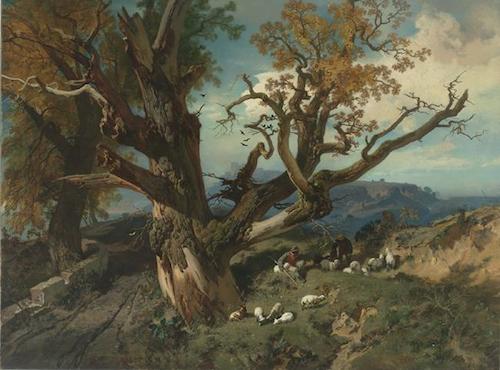OVERVIEW OF THE COLLECTION
The European Art Department at VMFA comprises more than 10,000 objects in all media dating from the Early Middle Ages to the 20th Century, including paintings, sculptures, decorative arts and works on paper. It includes the Mellon Collections of British Sporting Art, French Art, American Sporting and Historical Art, and Jewelry and objects by Jean Schlumberger. It is overseen by Dr. Mitchell Merling, Paul Mellon Curator and Head of the Department of European Art.
HISTORY OF THE COLLECTION
In 1911, VMFA founder Judge John Barton Payne donated approximately 100 works to the museum, including European and American paintings and works on paper. In the 1950s, VMFA benefited greatly from the Adolf D. and Wilkins C. Williams Collection and gifts from Margaret and Arthur Glasgow. These collections and bequests of funds furnished the means to purchase a small but representative collection of European paintings selected by former Paul Mellon Curators Pinkney Near and Malcolm Cormack. The decorative arts collection was enriched by gifts from Ailsa Mellon Bruce (especially a large collection of 18th- and 19th-century snuffboxes) and members of the extended Branch family. In the 1980s, Mr. and Mrs. Paul Mellon gave selections from their collections of French 19th and 20th century art, and the Paul Mellon Collection of British Sporting Art, as well as American sporting and historically significant paintings. Mr. and Mrs. Jerome T. Gans, and later Mrs. Rita Gans, gave their outstanding collections of English silver in 2007 and 2010 respectively. Mrs. Nelson St. Clair has given an important group of animal bronzes by Antoine-Louis Barye, Recently, VMFA has acquired a select group of French 19th century paintings, mostly by purchase, but also enriched by significant gifts from Jane and Joseph T. Knox.
HIGHLIGHTS OF THE COLLECTION
Medieval and Renaissance Decorative Arts and Sculpture:
An ivory mirror back representing a joust; a series of life-size French Gothic, limestone sculptures; a German Renaissance polychrome sculpture group; French Renaissance enamels by Jean de Court and other masters; Italian maiolica by Guido Durantino and others; an early French tapestry depicting the Marriage of Rigualt d’Oreille
European Paintings before 1800:
Masterpieces of Italian Renaissance art by Altichiero, Lo Scheggia, Andrea di Bartolo, and Il Bacchiacca; a representative and fine group of Baroque art from throughout Europe by Murillo, Poussin, Claude Lorrain, Rubens, Jan Brueghel the Elder, Teniers, Molenaer, TerBorch; a distinguished gallery of 18th-century paintings by Watteau, Fragonard, Hubert Robert, Francesco Guardi, GianDomenico Tiepolo, Elisabeth Vigée-Lebrun, and Francisco Goya.
European Paintings and Sculpture after 1800:
A recent effort to acquire deeply in this area has resulted in distinguished holdings of academic and official and other art by Bouguereau, Winterhalter, Doré, Gustave Moreau, and Alfred Stevens. Non-Mellon Impressionist and Post-Impressionist art includes masterpieces by Monet (3), Renoir (2) and Bonnard. Sculptures in this area comprise a bronze group of The Dance by Carpeaux, a plaster study by Pio Fedi, and a large group of separately displayed French animalier sculptures, including Antoine-Louis Barye.
European Tapestries:
Now displayed in the original Great Hall of the 1946 building this impressive group comprises six subjects from Don Quixote from the Gobelins manufactory, originally in the palace at Marly and once belonging to Louis XV; two Beauvais tapestries glorifying Louis XIV; and 4 scenes from the life of Moses by Jan Leyniers of Brussels.
English Silver from the Collections of Mr. Jerome and Mrs. Rita Gans:
One of the most important collections of this material in the world, comprising over 100 objects by London makers such as Anthony Nelme, Paul de Lamerie, Paul Storr, and Robert Garrard, among others. Signal pieces include Storrs’s large sculpture of Hebe (after Canova), the “Drury Lowe Tureen” by Lamerie, and a pair of rare Elizabethan livery pots.
The Mellon Collections:
The Paul Mellon Collection of British Sporting Art must be considered the most important dedicated museum installation of this material in the world. It contains a comprehensive survey of art depicting the heyday field sports (hunting, racing, fishing and shooting, as well as coaching) from its inception in the 17th Century until the Early 20th Century. Artists represented include James Seymour, John Wootton, seven paintings by George Stubbs, Sir Francis Grant, James Pollard, John Frederick Herring and Sir Alfred Munnings. The display also includes Herbert Haseltine’s sculptural series of British Champion Animals.
The Mr. and Mrs. Paul Mellon Collection of French Art offers a unique glimpse into the range and quality of their personal collecting, including major works by forerunners of the Impressionists such as Géricault, Delacroix, Courbet, and Boudin. Impressionism is represented by major works by those artists, including important works by Manet, Monet, Renoir, Morisot and Caillebotte. Degas is represented in depth by 4 paintings and nine original wax sculptures (the second largest group of these in the world). Post-Impressionism is represented by key works by van Gogh, Gauguin, Bonnard, Vuillard, and Le Douanier, Henri Rousseau. A small but choice selection of 20th-century works by masters such as Picasso, Matisse, and Mailllol.
The Paul Mellon Collection of American Art contains a large selection of American sporting subjects both by sporting specialists such as Fisher and Troye, but also by more generally known artists as Eakins and Homer. A large group of North and South American scenes by George Catlett from his Indian Gallery offers unique insight into the early Americas. Masterpieces by Homer and Eastman Johnson of Civil War subjects round out other historical material from this period. The dedicate gallery forms an important postlude to the VMFA’s American holdings.
The Mrs. Paul Mellon Collection of jewelry and objects by Jean Schlumberger, reveals the depth and quality of her patronage of this seminal Franco-American master designer. It will soon be returned to its own dedicated gallery adjacent to the other Mellon Collections.
Animal Sculpture: a full and representative display of approximately 60 animal sculptures by French artists such as Antoine-Louis Barye.
List available upon request
